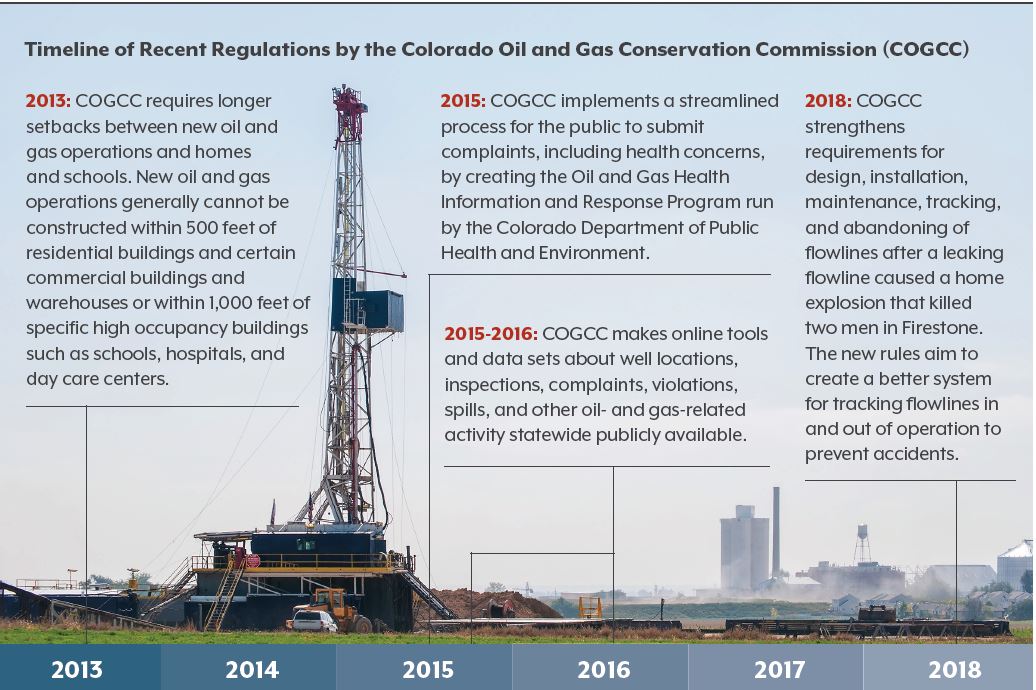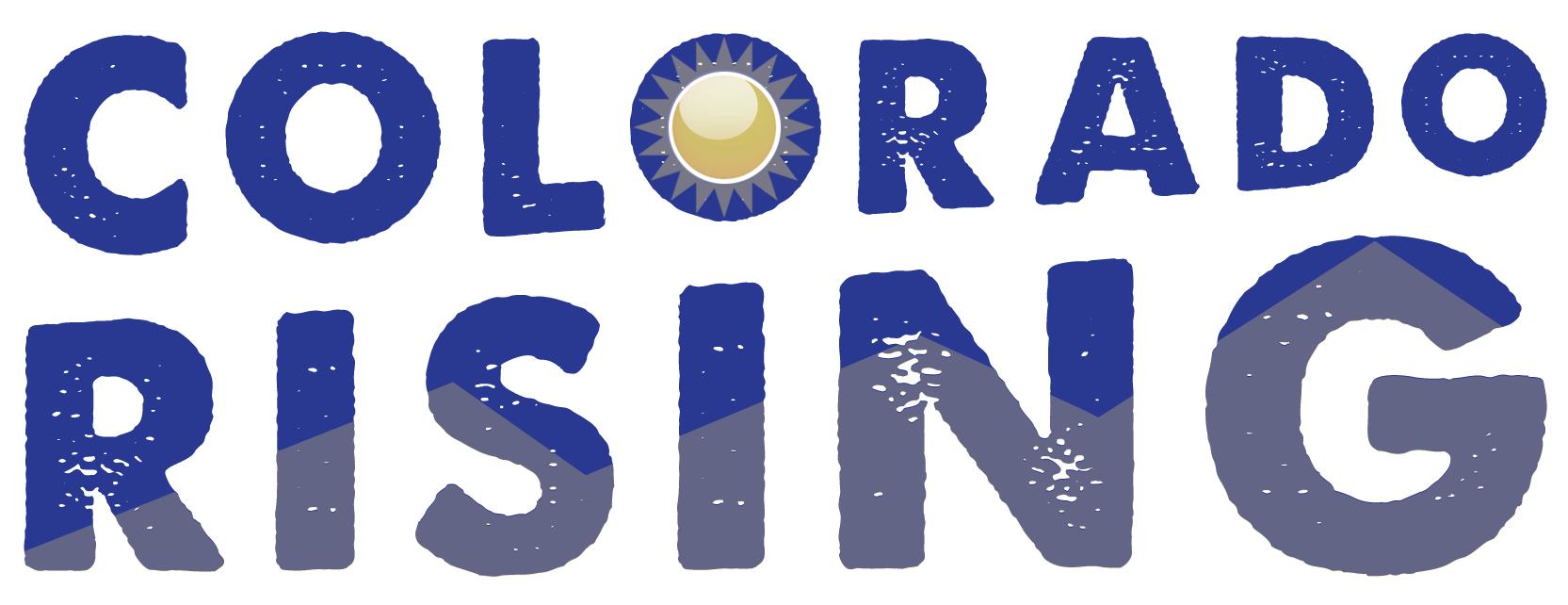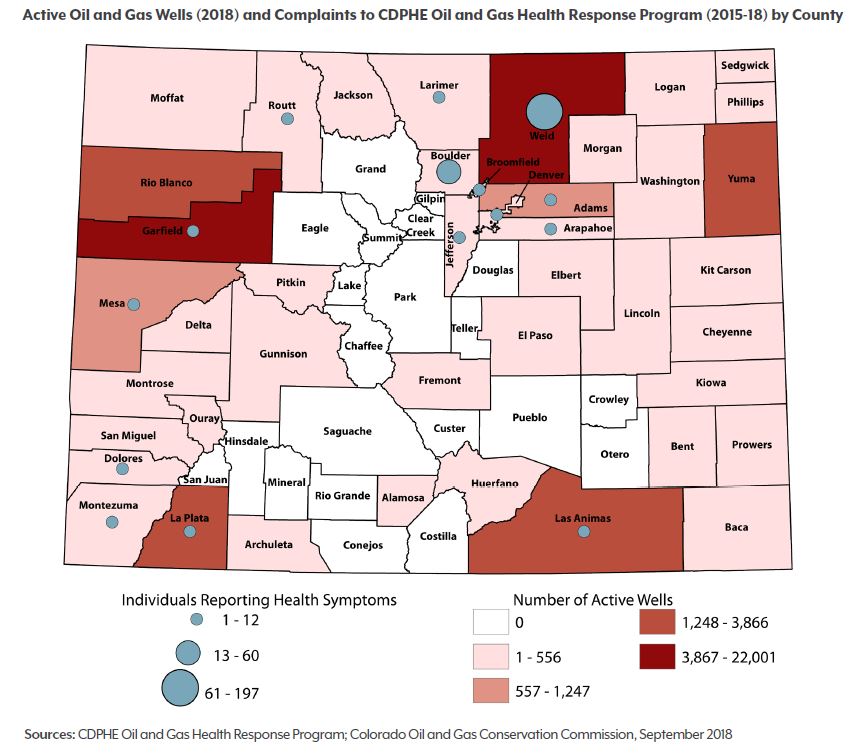
Is 2,500 the Magic Number to Protect Public Health?
Key Takeaways
Proposition 112 would increase the minimum distance required between new oil and gas wells and homes, schools, and other designated areas to 2,500 feet — more than twice the current required distance — in an effort to protect public health.
Coloradans are reporting health concerns such as headaches and respiratory problems in areas with high oil and gas activity.
The evidence that a 2,500-foot setback will protect health is currently limited, and further research is needed.
The push to increase setbacks stems from concerns about air and water pollution among the growing number of people who live near oil and gas wells as drilling has expanded into more urban and residential areas, especially along the Front Range.
Colorado is a top 10 producer of both oil and natural gas nationally and has seen an increase in development in the last decade, which has contributed billions to the state economy and created thousands of jobs.1 Oil and gas drilling used to be located primarily in rural areas, but new drilling technologies and Colorado’s population boom have brought the industry into close contact with suburbia and its residents.
As a result, residents and some local governments have tried to enact tighter regulations related to drilling. The oil and gas industry has successfully fought those attempts. Local ordinances have been overturned in court, and a previous citizen’s initiative did not qualify for the ballot. Proposition 112 is the latest attempt to push drilling farther away from residential areas.
This brief includes what the initiative proposes, viewpoints from both sides, health concerns reported to the state, and the Colorado Health Institute’s assessment of the evidence.
Proposition 112 at a Glance
- Increases the required setback distance for all new oil and gas drilling on nonfederal lands in Colorado to 2,500 feet (approximately a half-mile). The current requirements are 500 feet from homes and 1,000 feet from schools and hospitals.
- Includes the start-up of an oil and gas well previously plugged or abandoned in its definition of new drilling.
- Declares that living close to oil and gas operations has detrimental impacts on public health, safety, welfare, and the environment, and that the impacts are reduced by locating oil and gas operations farther from occupied structures and vulnerable areas.
- Defines “occupied structures” as “any building or structure that requires a certificate of occupancy, or building or structure intended for human occupancy, like homes, schools, and hospitals.”
- Defines “vulnerable areas” as including playgrounds, sports fields, public parks, and waterways and would allow local governments to define additional locations as “vulnerable areas.”
For More Information
For a complete overview, read the 2018 State Ballot Information Booklet, pages 82–85.
http://leg.colorado.gov/bluebook
The Colorado Health Institute is a nonpartisan, independent research institute. CHI does not advocate for or against Proposition 112 or any other ballot issue or piece of legislation. This report is intended to help inform voters by compiling views and concerns of proponents and opponents of the initiative and providing context on oil and gas regulation as it pertains to health.
For and Against
CHI examined the arguments of two groups leading the campaigns for and against Proposition 112: Colorado Rising, the political committee behind the proposition, and Protect Colorado, a political issue group created by oil and gas companies.
Colorado Rising: Arguments for Proposition 112
- Current setbacks are not enough to protect public health, safety, welfare, and the environment.
- Oil and gas development, including hydraulic fracturing, can have detrimental impacts on public health, safety, welfare, and the environment overall.
- Two peer-reviewed health studies indicated that detrimental health impacts are greatest within a half mile (roughly 2,500 feet) of an oil and gas site.
Fundraising: $900,000
Protect Colorado: Arguments Against Proposition 112
- Current setbacks keep the environment and communities surrounding oil and gas development sites safe while fostering economic prosperity in Colorado. An extension to 2,500 feet will limit development, cost jobs, and hurt the economy.
- The Colorado Oil and Gas Conservation Commission, the state’s regulatory agency, estimates that 85 percent of all nonfederal land in Colorado would be off limits to drilling if setbacks are extended. A separate study from the Colorado School of Mines that considered additional mining technologies found that 58 percent of nonfederal land would be off limits.
Fundraising: $34,700,000 (Some of this money supports Amendment 74, a separate ballot measure that would require governments to compensate oil and gas companies and others if a law diminished the value of their property rights.)
Oil and Gas Health Concerns
Drilling in residential areas concerns some who live near oil and gas wells. The Colorado Department of Public Health and Environment (CDPHE) created the Oil and Gas Health Information and Response Program in September 2015 to respond to public concerns about health related to oil and gas activities.
As of September 2018, a total of 604 health concerns have been reported to the state by 317 people.
These concerns include short-term health effects such as headaches, dizziness, and irritation to eyes, nose, throat, and lungs.4 Some also report anxiety and sleep disturbance from vibrations and noise from drilling.5
The most common self-reported health concerns between 2015-18 included:
- Respiratory symptoms, such as irritation to or problems with nasal passages, lungs and throat: 330 complaints
- Neurological symptoms, such as headaches and behavioral effects (including learning or sensory function problems): 155 complaints
- Gastrointestinal symptoms, like stomach aches, nausea and intestinal problems: 61 complaints
Where are the most self-reported health concerns?
Most of the reports come three Front Range counties: Weld, Boulder, and Adams.
Nearly two-thirds of people who filed complaints (197 of 317 people) live in Weld County, which has the most oil and gas wells in the state (22,001). Boulder County had the second highest number of people reporting health concerns at 60 — about a fifth of the total who filed complaints. Boulder County has just 305 active wells, but there is a high concentration of wells in southwest Weld County that are close to towns in Boulder County.
The Western Slope counties of Garfield, Rio Blanco, and La Plata also have thousands of wells each. However, those wells tend to be older. The state’s current drilling boom is happening in and around Weld County.
Is 2,500 Feet the Magic Number To Protect Health?
Proponents of Proposition 112 say that the 2,500-foot setback distance is based on findings from two peer-reviewed studies from the Colorado School of Public Health that looked at residential proximity to oil and gas development and health outcomes, such as childhood cancer and birth defects. 6
The two studies, published in 2014 and 2017, show a positive association between living close to oil and gas development sites and childhood cancer, congenital heart defects, and neural tube defects. These studies showed that the farther away people were from oil and gas sites, the fewer cases of negative health effects.
However, there are a number of limitations to the studies’ designs.
A 2017 assessment of potential public health effects from oil and gas operations in Colorado, released by the CDPHE, concluded that results from exposure and health effect studies, including the two studies used to justify the 2,500 foot setback on the 2018 ballot, “do not indicate the need for immediate public health action” as there was “no substantial or moderate evidence of health effects of communities living near oil and gas operations.”
According to CDPHE’s assessment, the studies used indirect exposure measurements (density of and distance from wells) as opposed to looking at emissions or production levels from the oil and gas sites. One of the studies focused on a small number of cases, making it difficult to generalize the results to the rest of the state.
The CDPHE report further explains the need for higher-quality studies to better understand the relationship between oil and gas development and public health effects.
Only about a dozen epidemiological studies that evaluate associations between oil and gas activity and health outcomes have been published — indicating a need for further investigation.
While there is evidence from the two studies cited on the ballot and other observational epidemiological studies that suggests an association between living near oil and gas operations and several health outcomes, the studies on their own are not enough to prove causality.
The evidence base for establishing a setback distance of 2,500 feet for all new oil and gas sites in Colorado to reduce health effects is therefore limited.
Conclusion
It’s clear that Proposition 112 would create major changes to oil and gas development in Colorado. If successful, it would greatly limit the amount of land on which operators could drill.
Regardless of the outcome of the election, concerns will remain about the health impacts of oil and gas development, as well as the future of an industry that’s a major contributor to Colorado’s economy and employment.
Win or lose, Proposition 112 underscores the need for evidence-informed health policy making.
As it stands, current studies of populations living near oil and gas operations in Colorado provide some, but limited, evidence of the possibility for harmful health effects.
Voters will decide if 2,500 feet is the magic number November 6.
Endnotes
1 U.S. Energy Information Administration. (2018). “Colorado State Profile and Energy Estimates.” Retrieved from: https://www.eia.gov/ state/?sid=CO
2 Colorado Oil and Gas Conservation Commission. (2018). “2500’ Setback Requirement for Oil and Gas Development. GIS-Based Impact Assessment.” https://cogcc.state.co.us/documents/ library/Technical/Miscellaneous/COGCC_2018_Init_97_GIS_ Assessment_20180702.pdf
3 Colorado School of Mines Payne Institute. (2018). “A Note on the Impacts of Proposition 112.” https://ljp6c3tnea61xd0wz1l33nmfwpengine.netdna-ssl.com/wp-content/uploads/ sites/149/2018/10/20181001_Maniloff_Commentary.pdf
4 Colorado Department of Public Health and Environment Oil and Gas Health Information and Response Team. (2018) “Health Concerns.” Retrieved from https://www.colorado.gov/pacific/cdphe/categories/ services-and-information/environment/oil-and-gas/oil-and-gas-andyour-health
5 Colorado Department of Public Health and Environment Oil and Gas Health Information and Response Team. (2018) “Health Concerns.” Retrieved from https://www.colorado.gov/pacific/cdphe/categories/ services-and-information/environment/oil-and-gas/oil-and-gas-andyour-health
6 McKenzie, LM, W Allshouse, T Byers, E Bedrick, B Serdar, and JL Adgate. 2017. Childhood hematologic cancer and residential proximity to oil and gas development in rural Colorado. PLoS One. 2017 Feb 15;12(2):e0170423. doi: 10.1371/journal.pone.0170423. PMID: 28199334.






